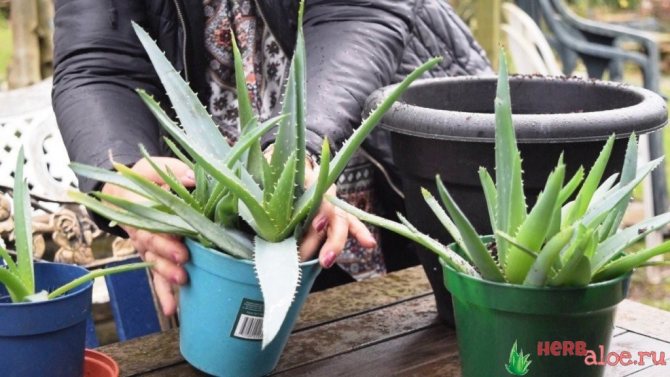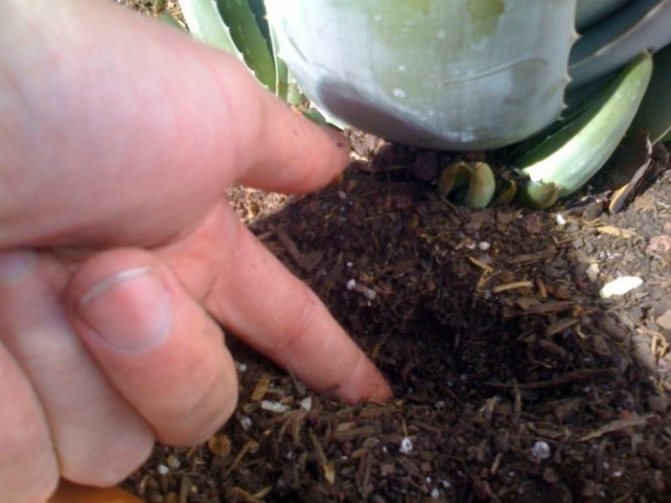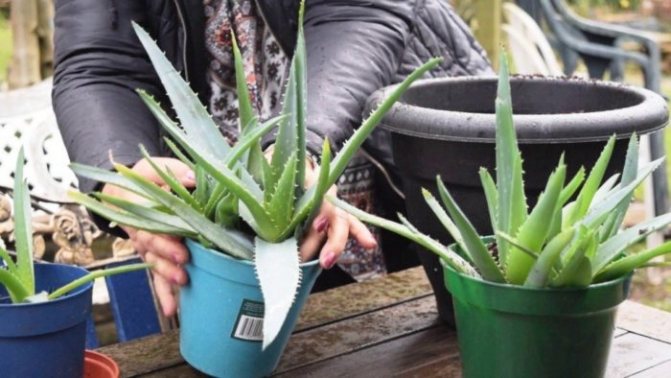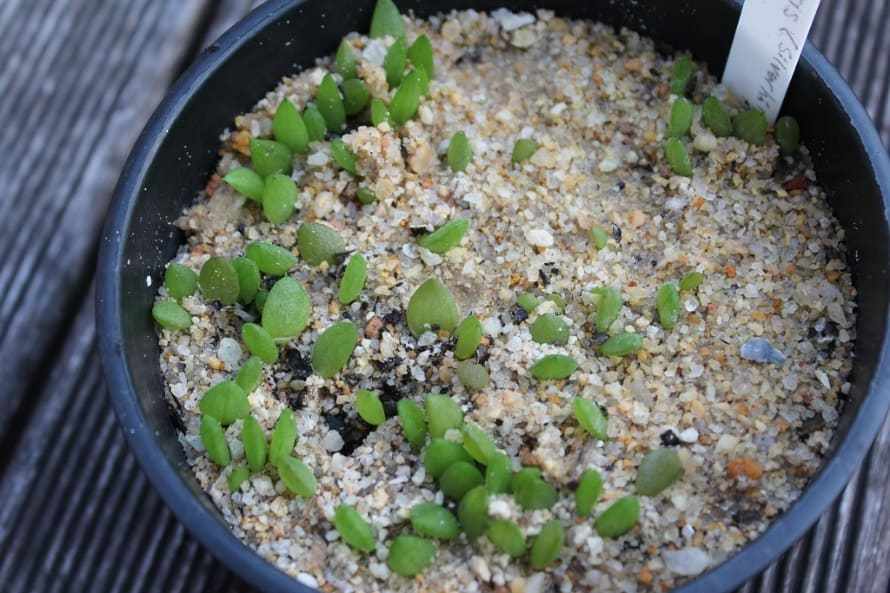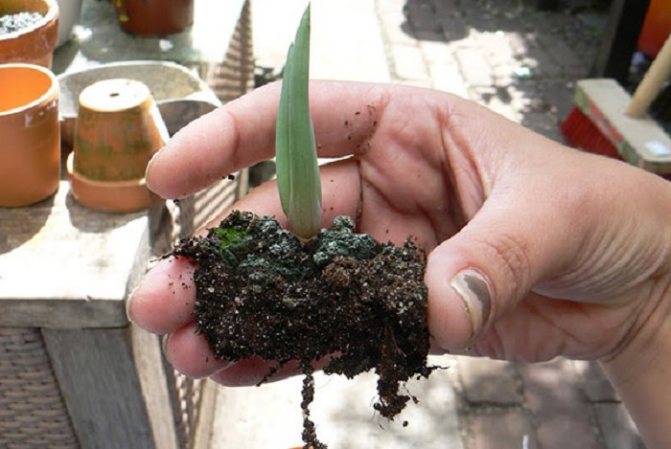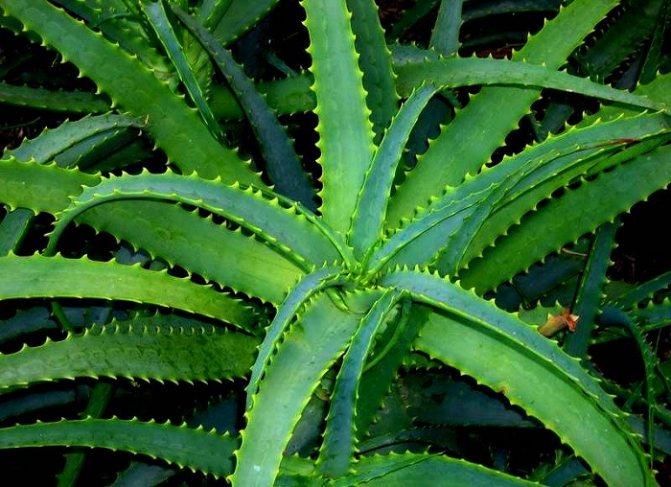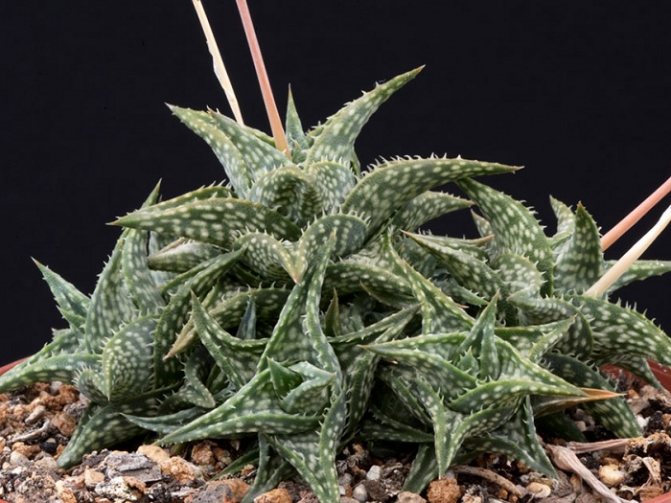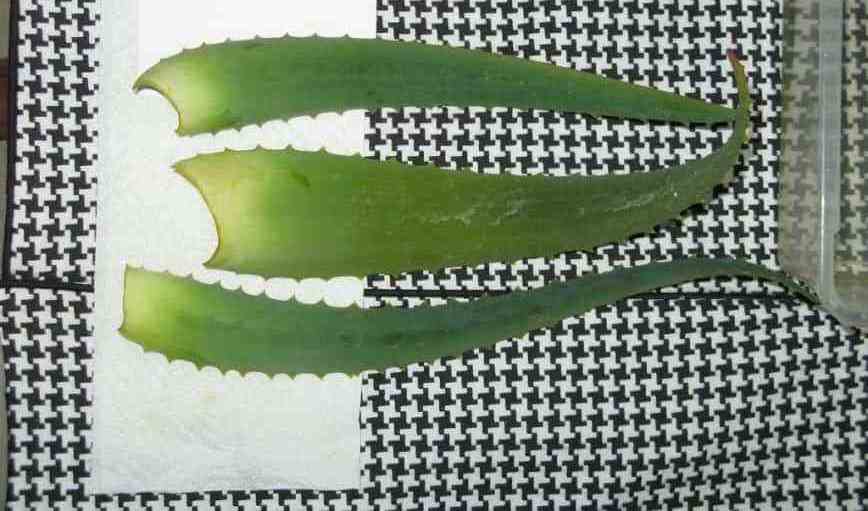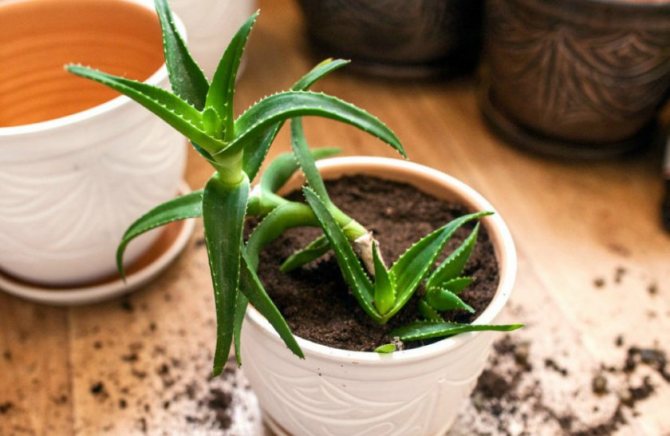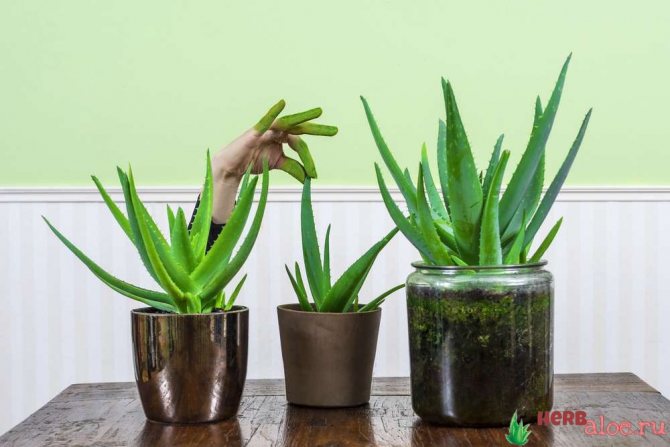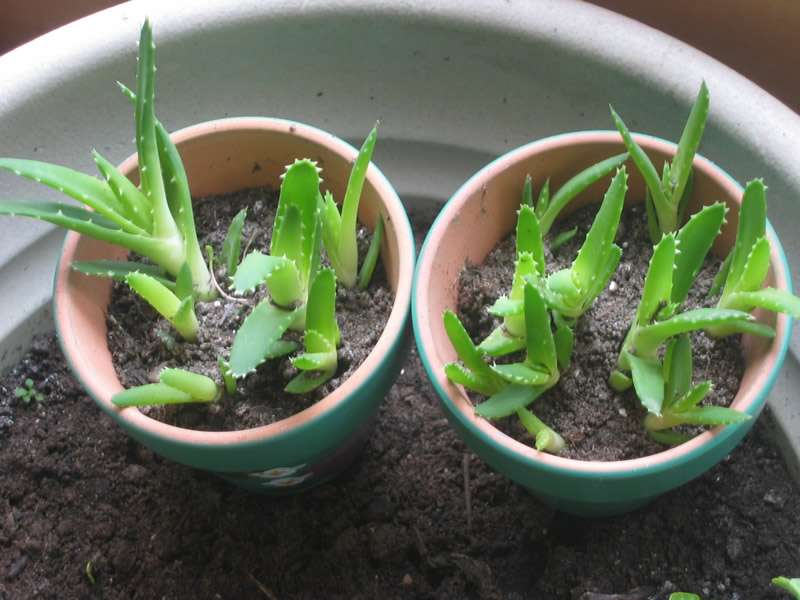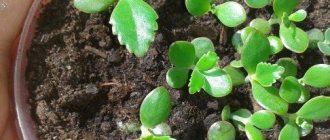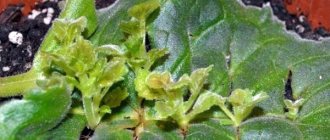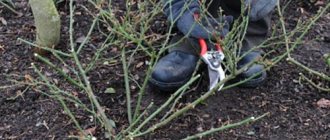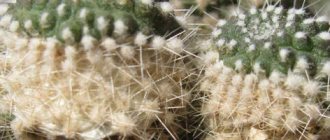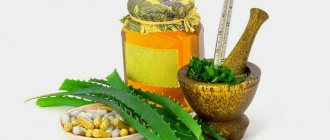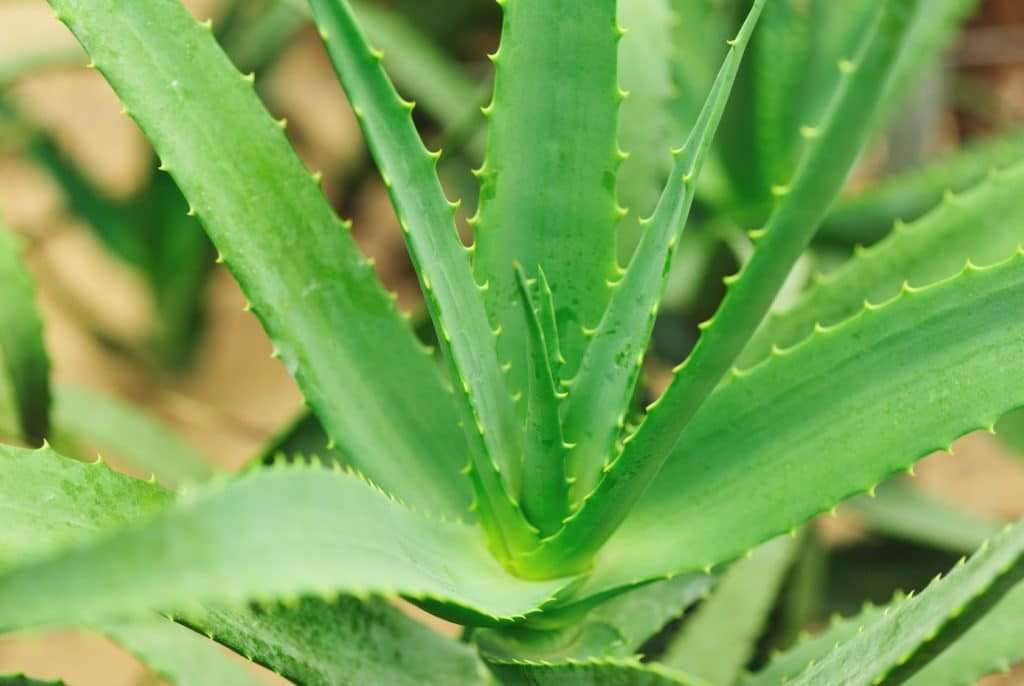
"African Guest" - aloe is appreciated not only for its exquisite decorative effect, but also for its unique medicinal properties. For thousands of years, people have used the healing juice in the preparation of various medicines. Today, aloe is used in both folk and traditional medicine, cosmetology. It is not surprising that growers are interested in how to propagate aloe at home and what it will take to complete the procedure.
Advantages and disadvantages of the method
This breeding method has several advantages:
- The method is very simple and does not require complex manipulations. Children grow up naturally. It remains only to carefully separate them and plant them in the substrate.
- Subject to all conditions, the planted processes develop successfully, do not get sick and do not die.
- The mother plant, freed from the babies, feels better. They no longer take up living space, do not take away some of the moisture and nutrients.
- Several bushes can be grown.
The disadvantage is that it takes a long time to form new shoots.
Using the top of the flower
Using the top of aloe for propagation injures the plant, but it is often used to rejuvenate an aged flower, and if its lower leaves and side shoots have already been cut off. This method is simple and easy to perform and leads to the rapid establishment of the apical process.
It is carried out as follows:
- the top must be cut so that there are at least 7 leaves on it;
- the cut off tip is dipped in a cut into a solution of phytohormone growth or other root growth stimulator and kept for 30 minutes;
- then the treated process is placed in a glass container with warm (but not hot) water;
- soon the first roots appear, and after they reach 6 cm, the rooted top is planted in the soil in a separate bowl.
Cut off the top only with a clean, sterile instrument, since the smallest contamination can provoke an infection in the flower. Some growers advise, after cutting off the top, to hold the shoot for several days in a dark room until a protective film forms, and only then put the top in water.
Reproduction by tips has such advantages as accessibility to even the most inexperienced growers and the ability to observe the growth of roots.
Houseplants are very diverse. Each of them has its own characteristics of growing and caring at home: the required light intensity, degree of humidity, soil composition, rules for transplantation, reproduction, etc.
One of the most unpretentious, adaptable to external factors, besides having outstanding healing properties, is aloe vera. How to propagate aloe on your own, which breeding method is the most effective? How often and in what quantity to water, what are the main conditions for the favorable growth of an amazing "home doctor"?
Selection and preparation of land


Aloe does not need too fertile soil... The substrate should be light and loose, water and breathable. Acidity is weak or neutral.
The ideal option is a special succulent and cactus soil that can be purchased at any gardening store.It contains enough nutrients necessary for the full development of young plants.
You can make a mixture according to the following recipe:
- sod land - 2 parts;
- sheet land - 1 part;
- coarse sand - 1 part;
- a small amount of ground charcoal;
- some small stones.
Peat should not be added as it increases the acidity of the substrate., which negatively affects the growth of aloe. Before planting, the soil must be exposed to high temperatures - calcined in the oven at + 90 ° C for 30 minutes.
Suitable soil
In order for aloe to grow well, you need to remember that it belongs to plants growing in hot countries. Accordingly, the conditions for its healthy growth, flowering and reproduction should be similar.
It is necessary to pay special attention to the soil, since the development of the root system affects the entire plant. If the soil is not chosen correctly, then the leaves of aloe may turn yellow, and soon the flower itself will die.
There are several basic rules to follow when choosing it. The soil should:
- Good moisture and air permeability.
- Contain enough iron.
- Be slightly acidic or neutral, which corresponds to ph 6.5-7 (ph is the degree of acidity).
To achieve looseness, the soil is mixed with sand, charcoal, small stones, gravel. It is not recommended to add peat.
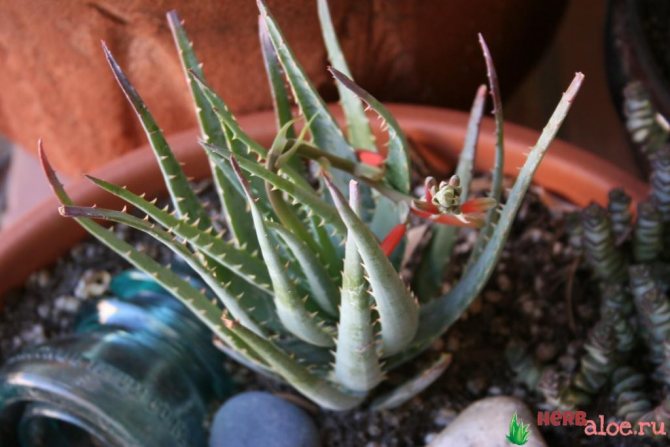

If it is decided to independently prepare the soil mixture, then mix:
- 2 parts of soil - sod, garden or deciduous
- 1 part humus
- 1 part sand
The soil needs to be processed before planting. There are 2 options for this:
- Watering with a light pink solution of potassium permanganate.
- Heat for about 30 minutes. An oven is used for this.
Ready-made soil for succulents is on sale, which contains all the necessary substances. Which soil to use, everyone decides for himself.
Reproduction by children
How to take a shoot correctly so as not to harm the plant? The shoots and main plant must be healthy.
- In order not to damage the aloe, you need to moisten and loosen the soil in the pot.
- Tilt the flowerpot on its side and remove the plant with the children from the container.
- Gently free the base of the aloe from the remaining substrate.
- Children already have a formed root system. You need to separate them manually or with a sharp knife. This should be done very carefully, without damaging the roots of the appendix.
If a young shoot has separated without roots, it is able to take root (how to properly plant aloe without a root is described here). It is necessary to powder the cut with charcoal powder, dry the baby for two to three days and then plant it in the substrate.
How to grow at home?
Now we will tell you step by step how to plant aloe without roots. The main methods are as follows.
Place the leaf in water, then in the ground


This method of growing aloe without a root part is the most common. Consider how to grow a shoot from a leaf for subsequent planting. The following steps must be observed:
- Prepare a glass container for the sheet, pour settled water at room temperature there and install the planting material.
- As soon as the roots appear, then remove the sheet from the water, lay it on a clean cloth.
- Leave the planting material in a warm place so that the film has time to form. This can take 2-3 days. The formed film will protect the plant from soil contamination.
- After that, you can transplant the plant into a prepared container with a drainage hole and 2/3 filled with a substrate.
The planted shoot does not need to be strongly compacted with earth, and after planting it should be watered with settled water. Set in a dark place for 2-3 days.
What if the flower does not root in the water?
On the question of how in this case to dissolve the roots of the agave, the opinions of flower growers differ.Some say that cut leaves, if planted in water before planting in the ground, will definitely give roots. Other growers are convinced that when they are in water for a long time, the leaves rot, so it is better to plant them immediately in the ground. So the right to choose remains with the florist. In any case, if the method turns out to be ineffective, then the rapid reproduction of aloe will make it possible to repeat this procedure without damage to the population.
Straight to the ground
This the method is standard, and for its implementation it is necessary to adhere to the following recommendations on how to grow roots:
- Cover the soil surface for planting with sand. It is better to use coarse grains, and its thickness should be about 2 cm.
- Immerse the fleshy leaf dried for 2-3 days in the ground with its lower part. The immersion height will be 2-3 cm.
- With the help of small leaves, cover the surface of the earth, pressing a little.
- At first, watering should be replaced for banal spraying.
- After 8 weeks, when the first roots are formed, irrigation must be excluded.
- Once the root system is developed, then transplant the plant into soil intended for succulents.
- The surface of the earth can be sprinkled with a mixture of sand and expanded clay aggregate.
Step-by-step instructions for planting in a pot
If the roots of the appendage are intact, it can be immediately planted in a pot., and this must be done correctly and accurately:
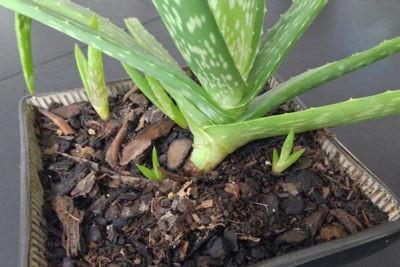

Prepare a medium-sized pot. It is desirable that there are several holes at the bottom of the container for better water drainage.- Pour a drainage layer about two centimeters thick at the bottom.
- Place a special primer on top.
- Moisten the soil.
- Wait 30 minutes for excess water to drain.
- Carefully spread the root system of the shoot and completely lower it into the ground. Immerse the scion a few millimeters into the substrate, leaving the growth point above the surface.
- Gently compact the soil around the scion.
- Water abundantly.
We recommend watching a video about the reproduction of aloe by children (shoots):
Best time
You can successfully propagate aloe at home if you know some of the necessary nuances. One such factor is the time that is best for it to breed. Reproduction is feasible in any season, but a particularly favorable time is the spring and first summer months.
At this time, the active vegetative development of aloe begins, which guarantees the fastest and most active growth of roots in the shoots. In other months, reproduction is also possible when the required temperature regime is created, but the rooting process may be somewhat delayed.


Outdoor cultivation
- Choose a not too humid place in partial shade. Do not plant in the open sun, otherwise burns will appear on the leaves. Arrange the flower so that the sun shines on it in the morning, and in the afternoon it falls into the shade. You can plant the shoot next to the tree, at a distance of one to one and a half meters, depending on the volume of the crown. Do not place near the trunk - the aloe will be dark.
- Having planted the shoot in the ground, tamp the soil around it a little.
- Drizzle with warm water.
Photo
See more photos on the topic below:
How to care for the first time after landing?
- At home, after planting, put the pot with a young plant in a cool place without direct sunlight.
- After a while, transfer to a warm, well-lit windowsill. Avoid direct sunlight.
- Water as the soil dries, about twice a week. Use settled water at room temperature.
- Provide an ambient temperature of at least + 20 ° C in the warm season and not lower than + 14 ° C in the winter.
- Wipe the sheet plates regularly with a damp cloth to remove dust from them.
- Arrange room ventilation.
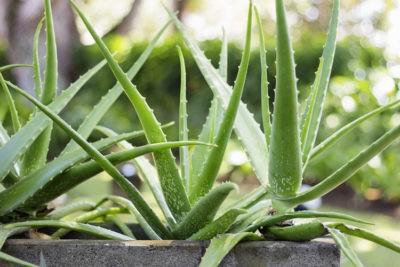

You can only feed it after the young aloe grows and gives new leaves. Special fertilizers for succulents are suitable. To prepare the solution, you must exactly follow the dosage indicated on the package of the drug. The frequency of the procedures is once a month. Top dressing should be applied only in the spring-summer season.- If the aloe is in the open ground and heavy rains have passed, be sure to let the top layer of the earth dry by three to four centimeters before watering.
- Aloe grows beautifully in the garden. From mid-September, monitor the decrease in air temperature in the evening and at night. When it drops to + 17 ° C, transplant the plant into a pot, hold it for three days on the balcony or veranda, then take it into the house.
Follow-up care
- Watering.
Aloe tolerates drought better than too much moisture. The plant is able to accumulate moisture in the leaves, so it can be without precipitation for some time. Young plants need to be watered once a week, and then the frequency of watering is reduced to 1 time in 2-3 weeks. - Lighting.
Aloe fully develops only under the condition of intense lighting. It is better to place a flower pot on a sill in the south direction. If the plant does not receive light, then its leaves will begin to grow unevenly and bend. - Temperature.
The flower grows actively at room temperature and can withstand a range of 12-30 degrees. In the summertime, the pots can be placed outside or on the balcony. With the onset of winter, be sure to move them indoors. The frequency of watering will depend on the air temperature.Note! The warmer it is in the room, the more water will be required for the flower.
We talked about other ways of breeding aloe in these articles:
- What are the secrets of growing aloe from seeds?
- Features of aloe propagation by cuttings.
If the plant does not take root
Usually young aloe grows rapidly and gains strength. If the plant does not take root well, the reason may be incorrect content:
- Unsuitable soil composition... For example, in a too dense substrate, flower growth slows down, aloe becomes lethargic, leaves turn yellow and dry at the tips. It is required to change the soil. Better to buy land specially designed for cacti. If this is not possible, prepare the correct soil yourself.
- Excess moisture in the soil... If you water the aloe too often and in large portions, the roots of the plant will start to rot. In this case, you need to completely dry the substrate and then constantly follow the watering rules.
- Lack of lighting... Aloe is a light-loving flower. Place it in a well-lit place.
- Exposure to direct sunlight... If a young plant stands under the scorching sun, there is a high likelihood of burns. Aloe should be shaded or transferred to a light-colored windowsill without direct open sun.
Propagation by cuttings
Cuttings are a very common propagation method and, if done correctly, leads to the rooting of all cuttings. This method allows you to successfully and quickly root all cuttings, provided it is carried out in the spring and summer. Lateral shoots from the main stem are used as cuttings.
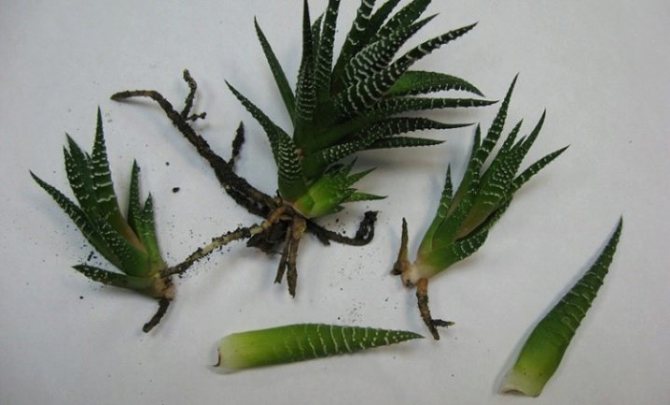

When grafting, perform several steps step by step.
- First, cuttings are selected. Choose well-formed, straight shoots approximately 10 cm long. The shoot should have at least 6 leaves.
- Cutting must be done with a sharp and short tool, so as not to damage nearby growing shoots and leaves. The instrument is pre-disinfected.
- The cut shoot is placed in a tightly closing cabinet or in a cabinety and leave for 5-7 days so that the cut dries up and becomes covered with a film. The moisture content should be approximately 50%.
- Prepare the soil mixture, including components such as peat, sand, ash, perlite, brick chips or fine gravel.
- The prepared container is filled (¾ volume) substrate and moistened sand (by a quarter of the volume).
- Cuttings are sprinkled with charcoal powder and planted, deepening into the soil by no more than 2 cm, with an interval of 4-5 cm between cuttings. The leaves can only lightly touch the soil.
- If necessary, you can sprinkle the surface of the soil with gravel to give the cuttings more stability.
- Container contain in a bright and warm (+20.25 degrees) room.
- Further care consists of in the systematic maintenance of soil moisture.
- After 2-4 weeks, the cuttings will take root, and after the appearance of new leaves aloe can be transplanted into separate bowls.
Read also: Reflection of autumn in water photo
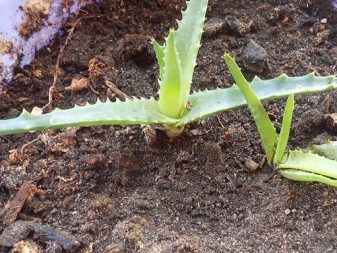

Before planting, the containers should be disinfected: a clay pot is treated with a superphosphate solution, plastic containers are washed with soap (household) and rinsed with hot water, ceramic bowls are thermally treated in the oven for 10-15 minutes.
How to plant scarlet?
Description
It is a perennial plant from the genus of succulents: with thorny, thick, fleshy leaves, convex at the bottom, and concave at the top, in a round or oval cross-section. Leaves are erect, strongly pointed at the top, collected on a rather thin stem, forming rosettes, painted gray-green or light green, with a thick waxy coating. Strong spines bent upwards are located along the edge of the leaf. Often, some species of this plant have lighter or, conversely, dark spots, strokes and numerous dots on the leaves.
In the room conditions of city apartments, some species, with a sufficient amount of light and heat, bloom annually, sometimes even several times a year. It emits a long flower arrow from the middle of a bunch of leaves with a tassel or a panicle of red-orange, white or yellow, tube-shaped flowers.
In indoor cultures, they are most often bred:
- Aloe Vera - bushy species with a short stem, orange flowers. It is the most popular type used in medicine and cosmetology.
- Aloe Arborescent (agave) - a highly branching tree, sometimes reaching a height of 2- 3 meters, flowers of various colors: yellow, orange, red.
- Aloe Variegated (brindle) - perennial stemless or very short-stemmed plant with dark green striped leaves. It stretches in height up to 40 centimeters.
- In medicine, aloe is used as a diuretic and laxative. Its juice has a pronounced anti-inflammatory effect, is effective in restoring damaged tissues (cuts, burns, bruises, frostbite).
- It is successfully used in the treatment of gastric ulcer, deep wounds, pulmonary tuberculosis, oral stomatitis, tonsillitis, inflammatory diseases of the female genital area.
- In cosmetology, it is used as a moisturizer. The juice is able to increase the elasticity of the skin, slow down the aging process. Restores damaged epidermis, protects the skin from ultraviolet rays, renews collagen.
Growing, breeding aloe at home
The most favorable period for plant propagation is early spring (February-March) or late summer (July-August).
The conditions for growing aloe are not demanding, because all that it needs for successful growth is:
- good sunlight;
- moderately warm room;
- moderate watering;
- limited watering in winter.
Aloe is grown in well-lit, dry rooms with regular watering in summer and a temperature of 12-14 ° C in winter, during this period watering is greatly reduced. With excessive moisture, the root and stem of aloe rot, the plant may die.
Aloe soil
Aloe soil is completely undemanding. At home, in Africa, it grows on dry, clay soils, with an iron content. At home, it takes root in a light soil mixture of turf, leafy soil and sand in a ratio (2: 1: 1).Young plants are transplanted annually, old ones - after 2-3 years, the soil mixture remains unchanged.
Watering
The hallmark of aloe is its ability to accumulate moisture in its leaves and stem. Accordingly, watering should be started 1-3 days after the soil in the pot has dried, while it is enough to water the plant 2-3 times a week with water at room temperature. When the soil is moistened, the moisture in the pot should not stagnate, so good drainage is necessary (sometimes up to 13 pots).
Diseases and pests
Aloe is quite resistant to diseases and pests. Like many plants with dense leathery leaves, it is often affected by an insect - the Scabbard. The pest almost completely covers the plant, and as a result, the leaves fall off, the shoots dry out. In this case, the insects are regularly cleaned from the leaves with a stiff brush, and the plant itself is washed every 5-6 days for a month with a solution of green soap.
How to grow aloe, how to plant aloe without a root?
There are several options for breeding this succulent in indoor conditions:
Cuttings from their pieces of leaf
When diluted by cuttings, the shoot is cut into pieces 10-15 centimeters long and dried in the air for 3-5 days. The surfaces of the slices, before being placed in the substrate, are sprinkled with crushed charcoal or activated carbon. How to plant an aloe plant in the ground?
How to propagate at home?


If you use aloe juice for medicinal and cosmetic purposes, then you have to pick off the lower leaves. The plant loses its decorative appearance, which means it becomes necessary to have several such plants. You can, of course, buy a ready-made flower in the store, but aloe is enough unpretentious both during transplantation and during reproduction, if you do not make gross mistakes.
You should know and follow fundamental rules, and then it is easy to create a new plant with your own hands:
- from the cutting;
- from the appendix;
- from a separate sheet;
- from seeds.
At home, aloe rarely blooms and it is rather difficult to get seeds from it in a natural way. But it is quite possible to purchase a bag of aloe seeds in the flower department.
Cuttings
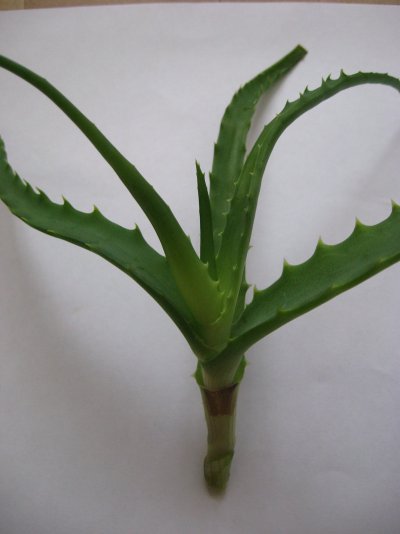

One of the fastest ways to get a mature, mature plant is to propagate by cuttings. The stalk you are planning to plant for breeding aloe should be about 10 cm long. It is more convenient to cut it off from the main plant with a sharp one (so as not to crush the cut plant tissue), but with a short knife to reduce the risk of grazing adjacent stems and leaves.
The resulting stalk is powdered at the cut site with coal dust and dried (dried) for 2-3 days at room temperature, avoiding bright lighting. Then, in an already prepared container with light loose soil at the bottom (3/4 of the height) and wet sand on top (1/4), they are planted to a depth of 1 centimeter slightly obliquely. If there are several cuttings, then the distance between them should be 4-5 centimeters.
Remember: never plant cuttings in clean water. Otherwise decay it is provided. You should not force the survival of young shoots with bright lighting and top dressing. A temperature of 20-25 degrees is acceptable.
With moderate soil moisture and light loosening at the edges, the aloe will take root and it can be transplanted in a month or a little more carefully to a permanent place in another pot.


Seed breeding
The method of growing aloe from seeds is the longest, but you can immediately get a whole plantation of plants. It is recommended to take dishes for germinating seeds flat and low. It is better to choose the time for sowing spring-summer. In this case, it will be possible to put the dishes for germination in the greenhouse and not spray to maintain constant humidity.
The seeds are laid out not closer than 1.5 cm from each other, slightly pressing into the ground.The soil itself must be disinfected in advance by heating or with a solution of potassium permanganate and, as in the case of cuttings, consists of sand and barren soil. Wet soil with seeds is sprinkled with dry clean sand per centimeter. Sufficient temperature for germination of aloe seeds is 22-25 degrees.
The first shoots will appear in 2-4 days. In the future, the sprouts are dived and transplanted into larger containers. But be prepared that you will have to wait for an adult plant about 2 years.
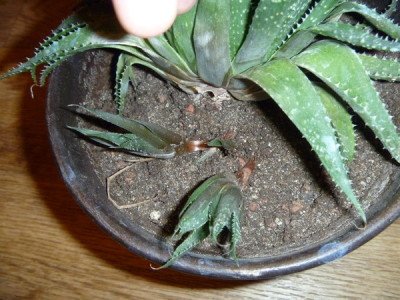

Propagated by shoots
A healthy adult plant will definitely produce young shoots coming from the bottom of the root outlet. Such shoots thicken the aloe and will soon weaken it, taking away food and living space. But in a new place, they will take root well and form an independent plant.
It is advisable that when separating already formed "children", as much as possible less damage to their roots... Gently peel the ground off the base of the aloe, try to do without a knife, just with your own fingers. If this succeeded, then it remains only to plant such an escape in a separate place.
If the "baby" is firmly rooted to the mother plant, then carefully cut it off, trying as much as possible keep its roots. An open cut is sprinkled with coal powder, similar to propagation by cuttings, and after exposure for 2-3 days, it is planted in a moist (not wet!) Substrate, trying to fill the voids. Read about planting and transplanting aloe here.
It is important to leave the growth point above the ground.
Water it a little a couple of times a week. It will be possible to feed young individuals only when they finally take root and give new leaves.
Even when a young shoot is completely detached from the roots, it is able to survive and grow. For this, planting methods similar to planting with cuttings (dusting with charcoal, drying for several days and subsequent planting) are applicable.
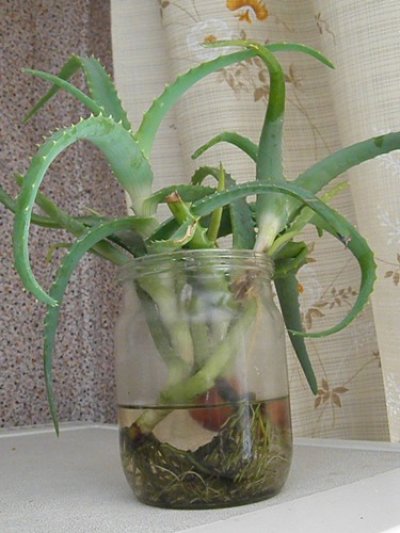

How to grow aloe from a leaf?
The most problematic is to use the method of propagation of aloe from its leaf. But it happens that the whole plant is damaged so much that nothing is left except for individual leaves. You can try and get good results.
From a capable plant, the lowest leaves are usually cut off. If there is no choice, then any will do. The cut is clean and even. Produced with a knife. Then you can treat the cut areas with charcoal (dust, powder) and slightly dry the sheet. Follow the same recommendations as for planting cuttings, but plant it in the substrate deeper - 2.5-3 centimeters. Sometimes it is advised to cover with a glass jar in the case of individual leaves to maintain humidity and temperature. And protect from direct sunlight until it finally takes root.
How to propagate aloe with the tip?
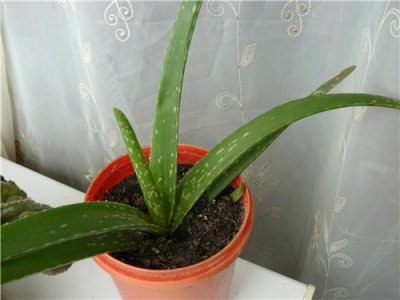

It so happens that the aloe starts out due to excess moisture or drafts rot down the trunk. It would be most prudent to keep the top of the head and try the next breeding method - a shank with a top. The main condition is as much as possible cut off the wet and rotten part faster, preventing the spread of the disease to the healthy top of the plant. It is best to do this a few centimeters higher from the site of the lesion. Then, it is treated with coal powder, briefly dried and planted in another place with healthy, moderately moist soil, followed by engraftment in it.
The principle of "underfilling is better than overfilling" is especially important for such a convalescent plant.
Preparing the soil and pot
Since the plant is adapted to life in the desert, then the soil for the tree-like aloe must be appropriate. On the wrong soil for aloe, the flower can get sick and die. As a rule, very little land is needed to plant an agave, so it is better to purchase a special balanced soil at a flower shop.A special earthy mixture for succulents and cacti is rich in nutrients that are necessary for the normal growth and development of not only young, but also adult plants.


When mixing soil for aloe at home, it is important to consider the following points:
- the ground should be slightly acidic or neutral;
- the soil should be easy to breathe and not retain water;
- for an agave, clay-sandy soil with a high iron content is more suitable.
In liquid black soil, this succulent will feel very uncomfortable. Do not mix peat with the soil, as it increases the level of its acidity. Most often, sod, leafy earth, humus and sand are mixed. Moreover, the sod soil is taken 2 times more than the rest of the components. You can mix some charcoal with the soil for the purpose of disinfecting and some small stones to make it looser.
Before filling the pot, it is advisable to subject the soil to high temperatures to reduce the likelihood of diseases and pests. A medium-sized container for an agave is chosen: a small dish will not allow a flower to grow, but a large one, on the contrary, will suppress its development. When choosing a container for planting, it is necessary to focus on the root of the flower - it must completely fit into the container at a distance of about 3 cm from the walls.
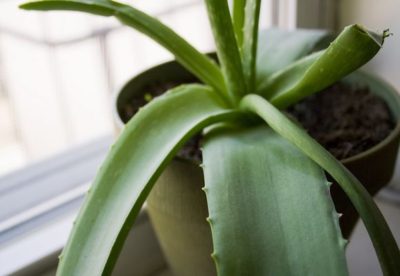

It is better to give preference to earthenware, where it will be easier for the roots to breathe, and excess water will not stagnate. Preparing a container for planting consists in filling it first with drainage, and then with a soil substrate.
Optimal time
Since aloe is a houseplant, it can multiply at any time of the year, the main condition will be to maintain a stable temperature regime.
But experienced florists say that it is best to carry out such work in early spring... It is during this period that natural processes are activated, and rooting occurs much faster.
If you adhere to all the recommendations described above, then the reproduction of aloe will always end in success. This plant takes root well. and getting young flowers is available even for a novice grower.
Houseplants are very diverse. Each of them has its own characteristics of growing and caring at home: the required light intensity, degree of humidity, soil composition, rules for transplantation, reproduction, etc.
One of the most unpretentious, adaptable to external factors, besides having outstanding healing properties, is aloe vera. How to propagate aloe on your own, which breeding method is the most effective? How often and in what quantity to water, what are the main conditions for the favorable growth of an amazing "home doctor"?
Growing from seeds
If you want to get a large number of plants, preference is given to growing from seeds. For a successful procedure, it is necessary to take into account all the necessary conditions:
- 1 Sowing time: last week of February - first week of March.
- 2 Temperature range: the room should have a temperature of + 21 ° С.
- 3 Capacity: small, flat.


The container is filled with soil that meets the requirements of the given plant variety. The soil is moistened, seeds are laid out on its surface, and then sprinkled with sand. It is important that the seed is no deeper than 1 cm from the surface. After that, the sown container is placed in a warm and humid greenhouse, where additional lighting is installed.
Watering should be done in moderation, but the earth should not be allowed to dry out. The sprouts that appear are sprayed with a spray bottle. And when there are 3-4 real leaves on them, they are transplanted into small pots, the height of which does not exceed 5 cm. The next transplant is made after 1 year into a large container for further development.
The seed method of growing aloe is considered the most difficult, therefore it is rarely used. However, in this case, the probability of plant survival is much higher than with cuttings or growing by shoots.
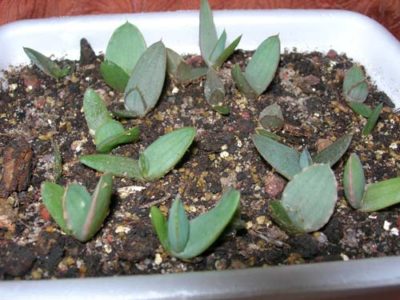

Specificity of care
The basis for a strong, healthy propagation plant is the following:
- Aloe Vera is a fast growing plant. When propagating, it should be transplanted into a larger container (shallow, wide, with drainage holes) once every 2 years. You can understand that the cultivation of aloe in a too cramped container is possible by the following signs: the flower stopped growing during the reproduction process, the leaves exceed the diameter of the container at least 2 times, instead of soil, there is an intertwined lump of roots. A ceramic container is preferable for aloe propagation, since ceramics removes excess moisture. To propagate a flower in it, the container must first be soaked for 1 hour in superphosate, washed with warm boiled water and soap, and ignited in the oven for disinfection. If you decide to propagate a flower in a plastic pot, you just need to wash the pot with hot water and soap.
- The soil. With each transplant, it needs to be updated. Aloe vera should be propagated in slightly acidic and moderately fertile soil. It is either bought in a store or prepared independently: a mixture of turf and leaves - 60%, humus - 15%, coarse sand - 15%, charcoal - 10%. Place a 2 cm high drainage layer (gravel, fine granite) on the bottom of the pot to drain excessive moisture.
- Top dressing. During the breeding season, aloe is fertilized once a year, in the spring. More frequent feeding will only harm the reproduction of the plant. Most often, fertilizers labeled 10-40-10 are used to propagate a flower.
- Pest control products. The main enemy that interferes with the propagation of the plant is the scale insect that drinks its juice. Method of struggle: wipe the leaves with soapy water or a weak solution of vinegar. Another pest is the spider mite. Prevention that increases the chance of healthy propagation of the plant: spray aloe with tobacco infusion using a spray bottle.
- Placement location. Aloe is a light-loving plant, therefore, in order to successfully propagate it, it must be kept in an apartment on the south, southeast side, but not in direct sunlight to avoid burns. It is necessary to accustom the plant to bright lighting during the reproduction process gradually - for a while, put it on the windowsill, balcony, street, then clean it under tulle, gauze. In winter, transfer to a bright, cool room with a temperature of 12-15 ° C.
In the process of breeding in the winter, it is a good idea to provide aloe vera with additional artificial lighting. With a lack of light, it is more difficult to propagate a plant - it stretches, turns pale. During the winter, the flower weaned from bright light, so in the spring you need to repeat the procedure for accustoming it to aggressive lighting.
Cuttings
You can grow an unpretentious flower from a cuttings cut with a sharp knife from an adult plant. For better rooting of the stem when cutting it, you must follow the following rules:
- at least 3 pairs of leaves must grow on it;
- the mother plant must be strong and healthy;
- the cut is sprinkled with crushed activated carbon to disinfect the surface;
- for several days the stem is dried in a dark place.
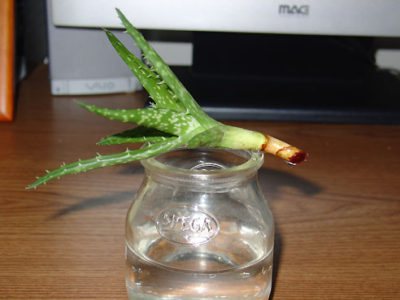

You can dry the cutting outdoors or in the refrigerator with medium cooling, after wrapping it in paper. After drying, start planting.
Leaf breeding
There are many methods of propagation of aloe, which differ in the length and complexity of the process. But it is the variety that allows you to choose the most acceptable way of breeding the agave. Leaf propagation is one of them.This method is usually used when it is necessary to rejuvenate an aged flower in order to give it a stimulus to develop.
You need to choose only a well-developed strong healthy leaf at least 8 cm in size. Then the actions are carried out in a certain order.
- The leaves should be cut with a clean and sharp tool from the very base of the stem. The cut should be oblique.
- Cut leaves, placed on a dry cloth (bandage, gauze, cotton napkin), should be left for 1-2 days in a dark room. The cut should dry out and be covered with a film.
- The dried cut is sprinkled with charcoal powder (activated carbon can be used).
- Next, a soil mixture is prepared from garden soil, sand and vermiculite, which is placed in a container and moistened.
- The leaves must be planted in the soil mixture, deepening them by about 3 cm.
- The container with leaves is placed in a fairly light and warm room.
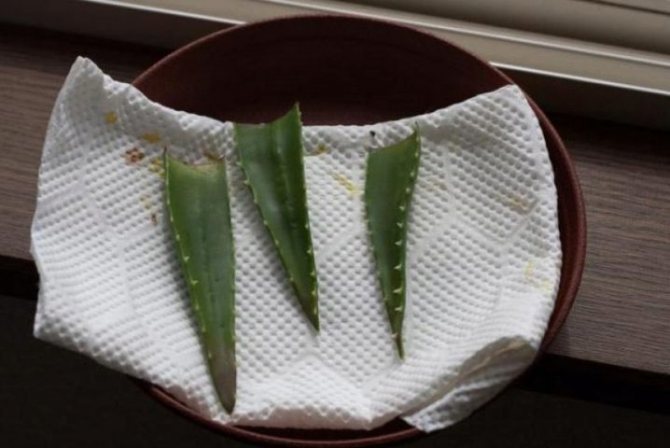

You can also not drop the leaves: they are simply laid out on the surface of the soil. The roots that appear later will themselves go into the soil. The planted leaves need to be watered regularly (every day) and abundant.
After the roots appear, the leaves will begin to grow, and young seedlings can be planted in separate bowls.
Landing "kids"
This is the name of the young shoots growing from the roots. This method allows you to grow several bushes from the babies surrounding the mother plant. In order for the agave to take root faster, you need to know how to grow an aloe from a shoot. When growing, you must follow the basic rules, which are as follows:
- shoots are transplanted with at least 3 young leaves;
- children are planted during transplantation of an adult plant for better survival;
- for planting, the children are cut off from the root with a sharp knife, leaving several roots on the process.
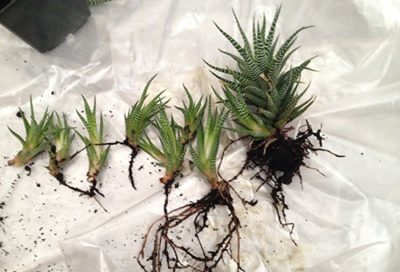

Whole children can be immediately planted in prepared soil, and damaged ones are best left for a few days to dry out.
Preparing a container for planting consists of the following steps:
- 1 Installation of drainage.
- 2 Filling in special soil.
- 3 Good soil moisture.
After the excess water drains into the tray (about half an hour after watering), you can start planting the bush. To do this, it is deepened into the soil by about 1 cm. For the first 10 days, the process is watered daily. At the same time, it is important not to allow the soil to dry out in order to prevent the root system from drying out at the shoot. Rooting should take place within a month and new leaves will appear.


Are there any chances of success?
While propagating and growing aloe from a rootless leaf is not an impossible task, the chances of growing roots are very small. The fact is that the sheets are saturated with moisture and tend to rot before their roots begin to form. You will find more nuances on how to grow aloe from a leaf in this article.
Planting a broken plant
An adult plant must be transferred very carefully. After all, large fleshy stems are very delicate, and if they are tilted unsuccessfully, they can easily break. In this case, the roots remain in the ground, and the upper part is no longer connected with them. Even in this case, you can save the flower, knowing how you can plant aloe without a root.
For this purpose, the main part of the plant is left in the refrigerator for several hours. During this time, you need to have time to prepare the soil and container for the flower. After moistening the ground, a stem is placed in it by 1-2 cm, and then the container is placed in a warm, sunny place. Care is carried out in the same way as usual: watered as the earth dries up.
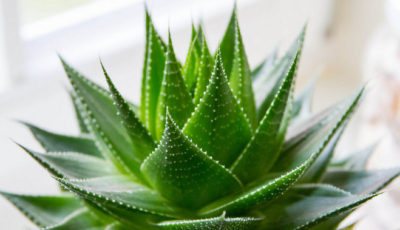

The succulent leaves of the plant, with proper care, are directed upward. If they do not have enough water, then they sink and begin to curl. With an excess of sunlight, they change color from green to brown. Compliance with all the rules of planting and care will allow you to grow a beautiful plant that will delight not only with its appearance, but also with high-quality medicinal characteristics.
Useful video
Despite all the unpretentiousness of the plant, it needs special care. The video will reveal several secrets that will help you grow aloe vera without any problems on your windowsill:
Aloe is a true natural medicine. The sap of the plant helps with colds, stomach and skin diseases. Masks for face and neck skin and hair are often made from aloe. Due to its beneficial properties, aloe has become a frequent guest on the windowsills of many hostesses. The rules of care are simple, but they must be adhered to so that the plant feels comfortable and produces powerful leaves.
When is the best time to do it?
Cutting, dividing a flower or transplanting is best done in early spring. At this time, the natural phase of root growth begins. The optimal time for sowing seeds is the last decade of winter.
The frequency of transplants depends on the stage of development of the succulent:
- aloe up to 2 years old is transplanted into a new pot annually;
- mature plants (up to 5 years old) rejuvenate every 2 years;
- the old agave needs to be thinned out and replanted every 3 years.
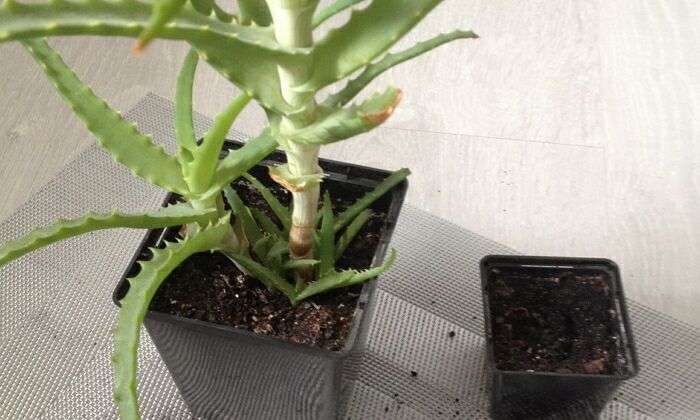

In some cases (root rot, soil pests, infections, cramped pot), an extraordinary transplant may be required to save the plant.
Important! It is not recommended to propagate the agave in the autumn-winter period. From October to February, the succulent is in a phase of passive growth, and an attempt to root in a new place will be unsuccessful.
Problems with the reproduction of aloe
When rooting cuttings, the most common problem is rotting of the base of the shoot from excessive moisture. This phenomenon is observed in the event that the cut of the appendage before deepening into the substrate is not dry enough, and the moisture of the soil mixture turned out to be excessive. Unfortunately, the rotten stalk can no longer be used for rooting, you just have to throw it away, cut a new one and start all over again.
The main problem when sowing seeds is poor germination. However, it all depends on the quality of the seeds, usually aloe emerges amicably. True, the time for germination differs in different natural species - in some, seedlings appear in a week, in others - a month later.
There is practically no hassle with the reproduction of aloe with the help of children, unless young plants are too much moisturized from the first days of transplantation and begin to feed early.
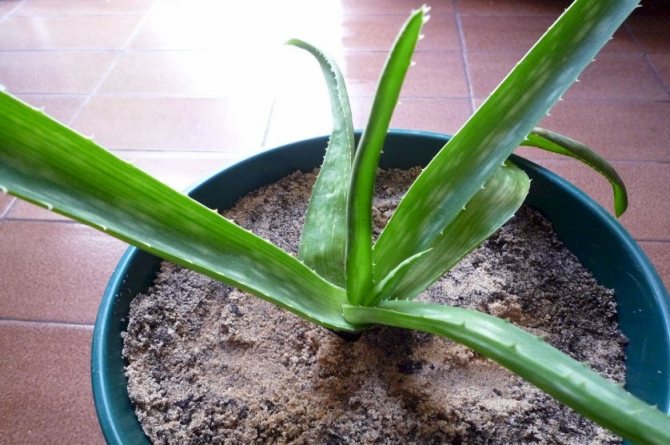

Growing aloe from root shoots
Under natural conditions, aloe multiplies by seed and vegetative. In many species, small processes grow, which are called babies. These are young plants associated with maternal root shoots. In stemless plants, small leaf rosettes appear nearby, and in such as, for example, an agave, a new trunk with several leaves.
When the shoots grow a little, and they have 4-6 leaves, they are separated from the adult plant and transplanted into separate flowerpots. Such shoots are formed, as a rule, in early summer, during the period of active growth of aloe. At the same time, plant transplantation is correct in the spring.
The step-by-step process of aloe breeding is as follows:
- An adult plant, along with young shoots, is carefully removed from the flowerpot, having previously well moistened the soil;
- Then they lightly shake off excess soil from the roots, trying not to damage them. In some species, the roots are quite fragile;
- Then the roots are carefully disassembled, separating the shoots;
- Having found the roots connecting the adult and young plants, they are cut;
- After that, the shoots are planted in separate flowerpots.
The photo below shows how the root shoots look like:
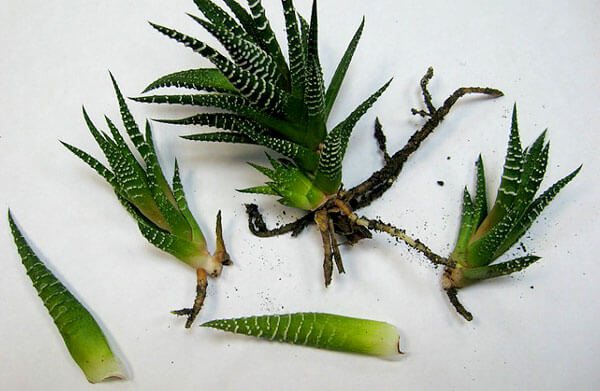

In some cases, the separation of the processes is carried out without transplanting the maternal aloe. First, they moisten the ground, and then gently dig out a young plant with their fingers. Having found the connecting root, it is cut.
Planting young plants is carried out in the same way as adults. First, a small and shallow flowerpot is selected, on the bottom of which a layer of expanded clay is laid out, which ensures soil drainage.Then a part of the soil is poured, on which the root of the plant is placed, and the rest of the earth is poured on top. The soil for aloe is neutral or slightly acidic. You can use a special mixture for succulents, or ordinary earth mixed with sand in equal proportions.
Can aloe be planted without a root?
Reproduction of the agave by planting the aboveground parts in separate containers is the most popular way of its reproduction. This method is less effective than breeding by budding, but it is much cleaner - you do not need to remove the plant from the pot to perform it. For planting without a root, take leaves, cuttings and tops of the stems.
The procedure is performed as follows:
- Cut off a fragment of the plant closer to its base.
- Treat the cut with activated charcoal or wood ash.
- Place the seedling in a cool, dark place.
- After the cut site ceases to emit juice, the process should be placed in well-moistened sand.
Within 10-14 days, the seedling will acquire its own roots and turn into a full-fledged plant.
Types of aloe for reproduction
There is no universal solution to how to propagate aloe of one kind or another. The methods are the same for all varieties. Florists who are engaged in the cultivation of these plants use the methods that are most convenient for individual species. Everyone chooses for himself how to breed aloe in his home.


Young shoots of aloe
Vera
Aloe vera is the most popular home grown species. Its distinctive features are a short stem and long fleshy leaves, collected in rosettes. The leaves are light green, covered with whitish spots, and have sharp thorns along the edges. They practically do not bloom, so seed reproduction is practically impossible for aloe vera. Most often, the reproduction of aloe of this species occurs in the apical way or with the help of shoots.
For your information! Aloe vera varieties differ from each other in color of leaves depending on the place of origin. They all have equal healing properties.


Aloe vera
Aloe tree
He is more often called an agave, because his life expectancy is simply amazing. Its main characteristic is long, pointed, elongated leaves attached to the stem. Thanks to them, it becomes clear how to breed aloe tree - by rooting the leaf.
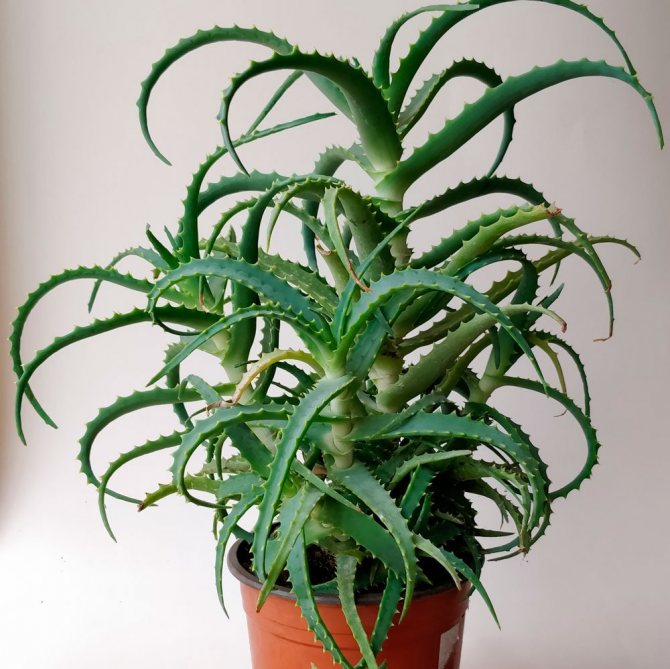

Agave
Aloe variegated (brindle)
It is characterized by a variegated color of long (up to 30 cm) leaves, due to which the flower got its name. The most convenient breeding methods: by tops or seedlings by children.
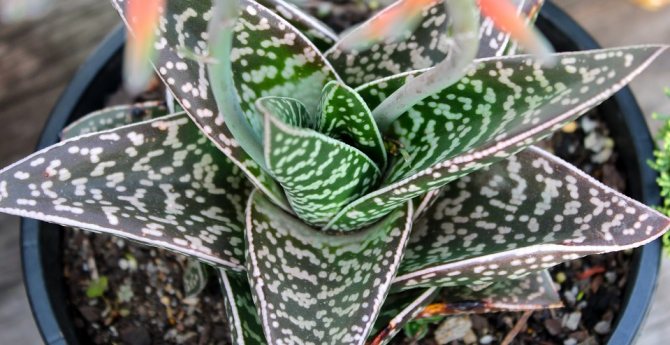

Aloe variegated
Aloe fan
Outwardly, it is a shrub with a gradually lignified stem. Leaves are rounded, long (up to 30 cm) and wide (up to 5 cm). A distinctive feature of this species is how the aloe fan reproduces. It is characterized by seed reproduction, which is rare for succulents. It blooms quite often, with proper care it does it annually. Scarlet flowers are located on long thin stems.
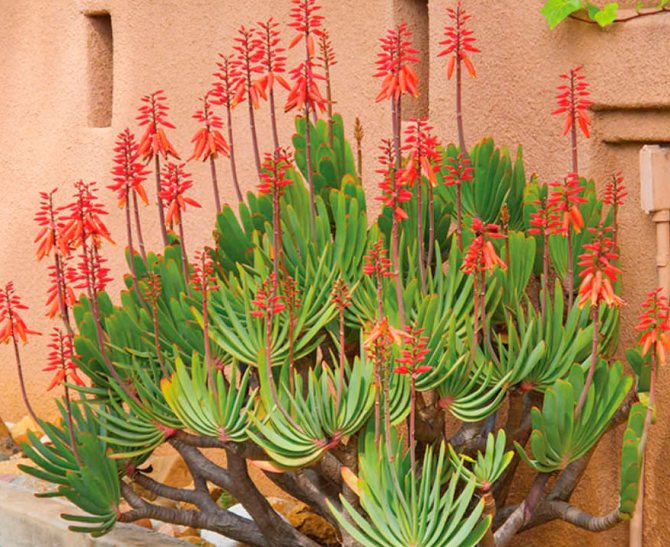

Aloe fan
Important! Everyone decides for himself how to propagate aloe, the main thing in this process is not to harm the adult plant - not to leave damage on it. But the rooting process itself is very simple, even beginner growers can handle it.
Leaves
The propagation of medicinal aloe can be done using a leaf. To do this, cut off a healthy leaf at the base of the plant. Place it on a tissue or paper towel and place in a dark place until the cut is dry.
Moisten the prepared potting mix. The place of the cut of the sheet is treated with charcoal or activated carbon, crushed into powder. Then it should be placed to a depth of no more than three centimeters. The soil should be constantly moistened before rooting.
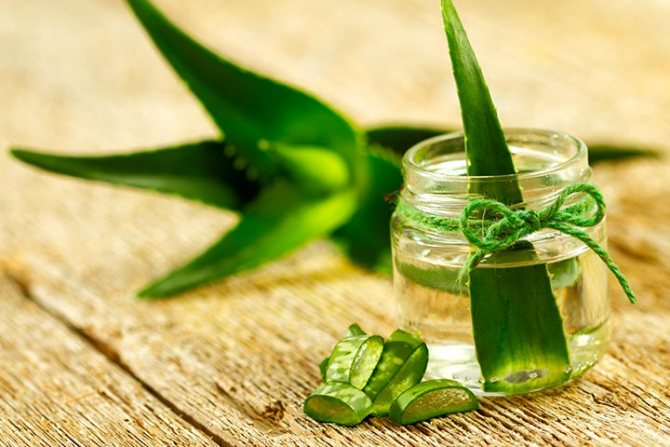

Can broken aloe be rooted?
The trunk of an overgrown aloe often breaks under the weight of the leaves and side shoots.But even such significant damage as stem breakage is not critical for the agave. To save the plant, you need to take the following measures:
- Renew the break with a knife and place the fallen off tip in a dry place.
- When the cut dries up (after 7-10 days), put the top in water or stick it in a pot with soil.
- Refresh the cut on the hemp and sprinkle with activated charcoal. Reduce watering further to stimulate kidney formation.
- When the stump produces many babies, remove it from the pot and distribute the daughter shoots into new pots.
Recommendations for further plant care
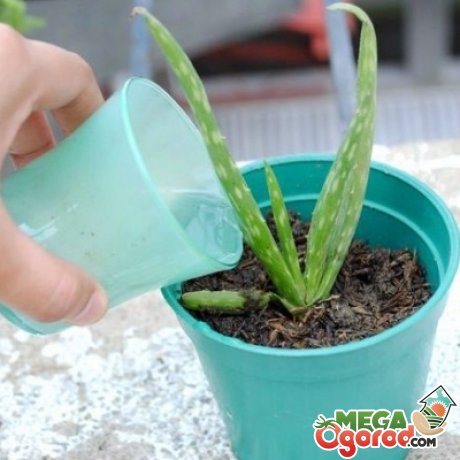

The rules for caring for a newly planted shoot are simple:
- Watering is carried out 1-2 times a week with settled water. It is not necessary to fill the flower, otherwise it will rot. For him, drying the top layer of the soil is better than finding the roots in swampy soil.
- Of the mineral fertilizers, mineral complexes are used for the agave, especially for succulents. Better to make them once a month.
- Spraying for aloe is not carried out. Leaves can only be wiped with a damp cloth, removing dust deposits from them.
- For a heat-loving plant, the air temperature in the room is important. It should not be below twenty degrees in summer and fourteen in winter.
- The flower does not tolerate stuffy rooms. Plants should be ventilated more often.
- Aloe also needs a lot of sun, but the bright rays of the luminary can burn the leaves.
- Of the parasites, aphids or scale insects attack succulents. If pests are noticed on the leaves, then wipe the plates with a cotton swab dipped in alcohol. Spraying with garlic tincture will help a young plant to get rid of insects.
Attention to its delicate shoots requires a decorative perennial from the owner.
Best time to breed
Each plant, regardless of its species and variety, has periods of active growth and dormancy. Aloe can be transplanted at any time, but it is best to do so in the spring and early summer months.
This is due to the increased activity of growth, which leads to a rapid adaptation to the new soil. As a result, the sprouts take root faster than in winter.
It is also noted that it is possible to maintain a suitable temperature in the room in the summer, which is quite problematic to ensure in the winter.
Basic rules for planting aloe
The purchased aloe must be transplanted. To exclude rot, you should carefully examine the root system of the plant. If there are rotten parts, they must be removed to a healthy area. Sections should be processed with crushed charcoal or cinnamon powder.
Also, when working with live plants, cleanliness of hands and tools is important. It is best to wear rubber medical gloves. It is advisable not to tear off the planting material, but to cut it off. Cutting knives must be sharpened and sterile.
For good growth of aloe, the composition of the soil is of great importance. For succulents, the bottom, drainage layer is especially important. It should be at least 3-4 cm thick. How drainage is poured onto the bottom of the pot:
- expanded clay
- pebbles
- rubble
Next, soil is poured, then a plant is planted on it. The roots need to be spread well over the surface. The earth is slowly poured up to the neck of the aloe root.
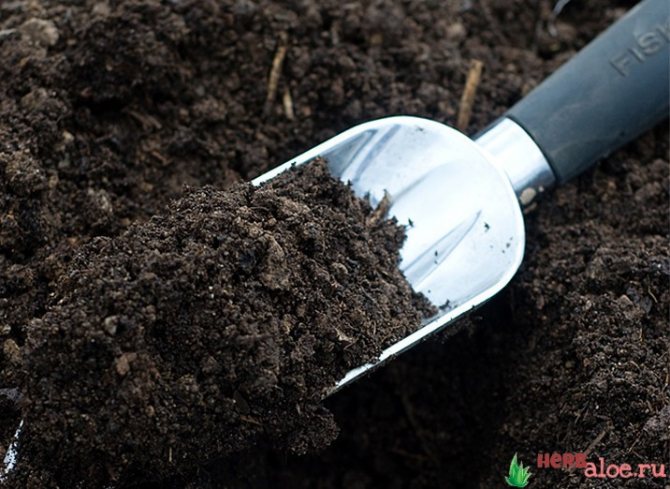

Important! Aloe roots are very fragile, so be careful when compacting the soil in a pot.
The root collar should be at the level of the topsoil. To protect it from decay, this vulnerable part of the aloe must be laid out in a circle with small pebbles.
After transplanting, you should not water the aloe for a week. During this time, it will have time to be rooted in the soil. In the future, watering should not be plentiful. The plant will need the first fertilization in a month.
The same procedure is used for the annual transplant of homemade aloe.
Tips on how to breed succulents
Professional florists recommend focusing on the following nuances of growing aloe:
- an adult, mature plant should stand on a windowsill, lit most of the day;
- in spring and summer, the agave is watered more often, in winter - as rarely as possible;
- aloe needs to be fed annually with mineral complexes and humus;
- if it was not possible to get rid of scale insects and mealybugs within 5 days with the help of insecticides, aloe must be immediately transplanted into new soil;
- once a season, the agave needs to be sprayed with Fitosporin.


5 / 5 ( 1 vote)
What time of year is it better to breed?


Experienced gardeners recommend reproduction of the plant in early spring and until the end of May, at this time of the year all natural processes are activated, the plant gradually leaves a state of dormancy or sleep and enters the growth stage, so at this time of the year it takes root more easily, it happens faster rooting.
In winter, the plant is at rest; it is undesirable to carry out transplantation, top dressing and frequent watering in cold weather. When transplanted in winter, the plant may die..
How to plant correctly?
The optimal time of the year for planting aloe is early spring, when all the plant's forces are concentrated on the development of the root system. The frequency of transplants depends on the age of the agave:
- young plants are transplanted annually;
- flowers 2-5 years old are transplanted into a new pot every 2 years;
- old aloe is transplanted every 3 years.
In order for the seedling to take root in a new place, you should follow the planting rules:
- Prepare a nutritious turf substrate.
- Spray the roots and aerial parts of the seedling with Phytosporin.
- On the third day after transplanting, place the pot on a well-lit window.
- Do not water the plant for 7 days after transplanting, so as not to provoke root rot.
- After 3-5 days, pour water into the pot tray.
- After two weeks, feed the agave with a weak solution of humus.
- Add infusion of wood ash to the water for irrigation.
Choice of land and pot
The substrate for planting should be slightly acidic (pH in the range of 6.0-8.0), loose and nutritious. Optimal recipe for soil mixture:
- 3 pieces of turf;
- 1 part vermicompost;
- 1 part peat;
- 1 part sand.
To save time you can buy a ready-made mixture "For succulents and cacti" in the store... It is also important to pay attention to the choice of the pot. It should be wide enough (up to 30 cm) for unhindered root development, as well as stable and made of ceramic.
Scion preparation: how to take a baby?
The process of taking a shoot is carried out in this way:
- The soil in the pot is thoroughly moistened to soften it and make it more pliable.
- The plant is carefully removed from the flowerpot and the maturity of the appendages is assessed.
- If they are sufficiently developed, they are separated from the rhizome with a garden trowel.
The most important thing when cutting off the "baby" is not to damage the root system of the mother plant.
How to transplant?
Appendix transplant algorithm:
- Rinse the roots from soil residues.
- Treat them with a weak solution of potassium permanganate or hydrogen peroxide. This is necessary for the prevention of infectious diseases and root rot.
- Place the scion on a drain in the center of the pot - so that the base of the stem is 3 cm below the edge of the pot.
- Holding the stem, sprinkle the seedling with earth. The soil should be sieved beforehand.
- Compact the ground and sprinkle with a thin layer of sand.
- Pour abundantly at the root.
During the first 3 days, the plant must be protected from direct sunlight (to avoid burns).
Attention! In most cases, aloe infection occurs at the time of the transplant. Therefore, all operations must be carried out in sterile gloves, the ground must be pre-steamed at a temperature of 60 ºС, and containers and equipment must be disinfected with a chloride solution.
Planting dates and the right choice of soil
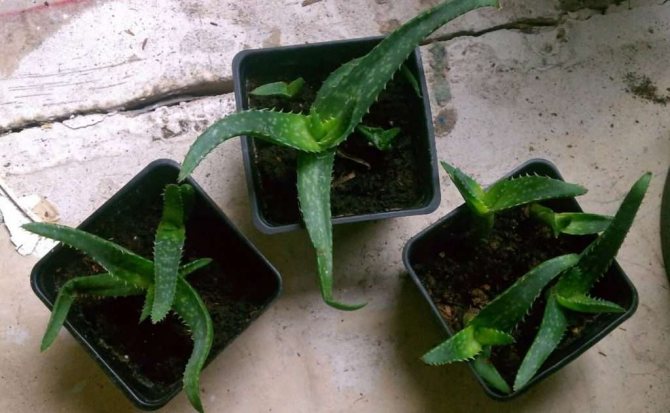

The most optimal period for planting aloe is spring.From mid-March to the end of May, the flower activates in its growth, develops rapidly and takes root in a new place. If necessary, planting a plant can be done in the fall or even in winter, but in this case, the probability of its death is high.
Before transplanting an aloe sprout, it is necessary to choose the right soil, which contributes to the rapid rooting of the sprout. It thrives best in balanced cactus soil. The main thing is that the substrate contains a lot of nutrients and iron.
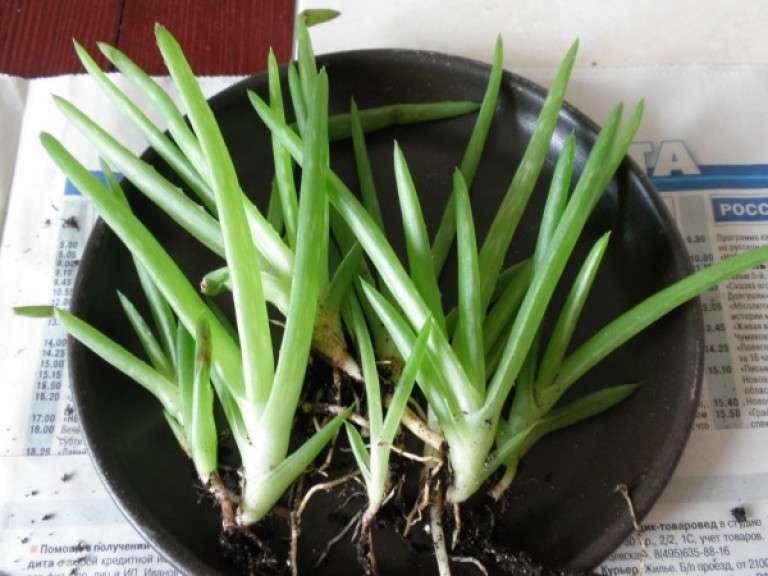

Basic soil requirements:
- it should be well loosened, with excellent air permeability;
- neutral or slightly acidic soil is most acceptable;
- charcoal or sand can be used as additives.
Biological features of aloe
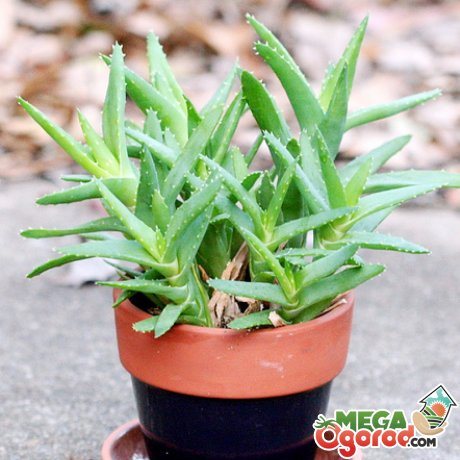

In nature, there are about four hundred species of aloe growing in Africa. But in home flower beds, aloe vera and a tree type of plant called an agave are most often found:
- In aloe vera, or Barbados, native to the Canary Islands, fleshy leaves with spines on the sides grow directly from the root rosette. The plant does not have the main stem, and it is small in growth, not even a meter.
The tree-like aloe reaches a height of two or more meters with good care. Over time, its powerful stem becomes covered with a lignified layer. Leaves with a dense glossy plate are located on the stem. They are oblong-lanceolate, oval in shape, and form a rosette in the upper part of the tree. The color of the leaf plate is dark green, sometimes covered with a bluish bloom. There are plant species with a beautiful color and pattern on the leaves.
Under their dense surface there is a flesh that tastes bitter. The juice contains substances that irritate the mucous membrane of the digestive system. Aloe blooms with orange or yellow flowers, collected in brushes or panicles. Although at home flowering of aloe is rare, the tree is used for decorative purposes.
The beauty and healing properties of aloe have brought him the love of most flower growers.
The leaves of both types of agave are used to treat constipation, colitis, insomnia. Healing ointments and tinctures are prepared from the juice. It is buried in the nose with a cold. The plant is attributed to the Asphodelov family, although there is still controversy regarding the classification among scientists.
Why do you need a scion
Planting an aloe without roots is an absolutely real task, for which you will need a branch of the plant. How to get a scion from aloe? It is carefully cut at a minimum distance from the stem, and the cut site is treated with activated carbon at the same minute. The cut off part is stored for a day or two in a dry and preferably dark place. During this time, a kind of film is formed on the sprout, which performs a protective function and serves as a conductor of nutrients.
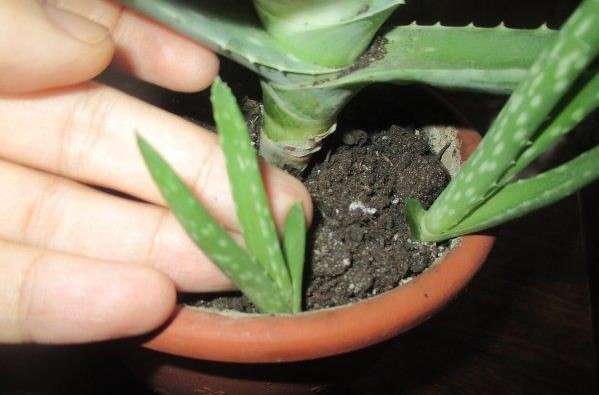

How to plant an aloe in a pot with a shoot? It is necessary to immerse it in the soil 2-3 cm with a cut down, so that it takes an upright position and is stable. It is also recommended to overlay small pebbles or sawdust on all sides so that the green mass on top of the soil does not touch the ground. The planting material is covered with a glass jar or a regular plastic bag. The pot with the plant is placed in a well-lit place. In order for some of the aloe to form roots more rapidly, it can be pre-treated with a growth stimulant.


Caring for a planted flower is quite simple:
- systematic soil moistening, plant spraying and airing;
- in order to prevent rotting, it is better to water with the help of a pallet placed under the pot;
- use only lukewarm water;
- keep the pot in a bright place, but protect the planted sprout from direct sunlight.
Key recommendations
For aloe, you should use a shallow plastic pot.It is also allowed to use heavy terracotta cookware. These containers, as a rule, do not have pores. Moisture will not evaporate through the walls of such pots, as is usually the case with earthenware. It is necessary to choose a container for the size of the flower. Its roots should fit easily in the pot (usually about 3 cm left to the walls).
In the process of keeping aloe, you need to transplant it regularly (about 1 time per year). In this case, not only the pot is usually replaced, but also the earth. It is worth knowing that the soil should be chosen loose and airy. It is advisable to take into account that the plant feels very bad in clay and black soil.
The land must contain components in the form:
- River, coarse sand.
- Gravel.
- Brick chips.
- Shell rock.
- Perlite.
Today, ready-to-use aloe vera mixture can be purchased at a specialty store. Usually land is bought for cacti. If necessary, add coarse river sand to it. If a person is going to independently prepare the soil for aloe, then the components should be taken in equal parts:
- clay;
- washed sand;
- humus.
Drainage must be placed at the bottom of the tank (broken bricks, small crushed stone can be used). It must be remembered that the holes in the dishes must remain open. Thus, excess water will drain.
Why propagate aloe?
Reproduction and transplanting is stressful, which can make the plant sick and wither. Before starting manipulations with aloe, you should make sure that there are sufficient grounds for flower reproduction:
- the old agave has entwined leaves, which is why he began to look ugly;
- many daughter processes have formed around the stem;
- pests have settled in the pot or the soil is acidic;
- the root system filled the entire space of the pot and began to crawl out over the sides;
- the pot began to overturn under the weight of the green mass of the flower;
- the agave stopped blooming and began to get sick often;
- the plant has stopped developing, the newly formed leaves remain small.
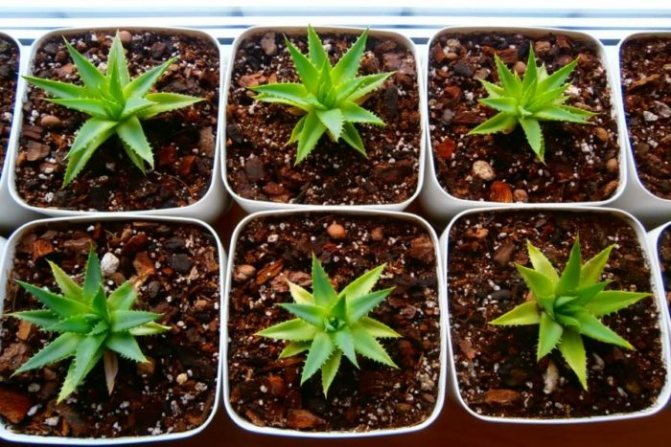

Important! The most common mistake of a novice grower is untimely transplantation. The centenary must not be left in the pot in which it was purchased! It must immediately be transferred to a large-capacity flowerpot.
Choosing a soil
In their historical homeland, aloes grow in very poor soils, but specialists have developed an optimal composition for cultural cultivation. It is he who can be bought ready-made in garden centers.
You can prepare the composition for planting a plant yourself. The main condition is that the mixture is loose, not sour. At the same time, it is not recommended to use peat for looseness.
For good air exchange, the following are used:
- brick chips
- perlite
- fine gravel
- shell rock
The main nutrient components of the mixture are clay, sod land, humus (equal amount).
Some lovers find the following composition (in parts) optimal for aloe:
- sod land - 6
- fertile land - 1
- rotted foliage - 2
- peat - 2
- river sand - 2
Indoor aloes need replanting annually. It is optimal to carry out this procedure in early spring. If necessary, the plant can be transplanted at any time, except for the holiday season (winter).
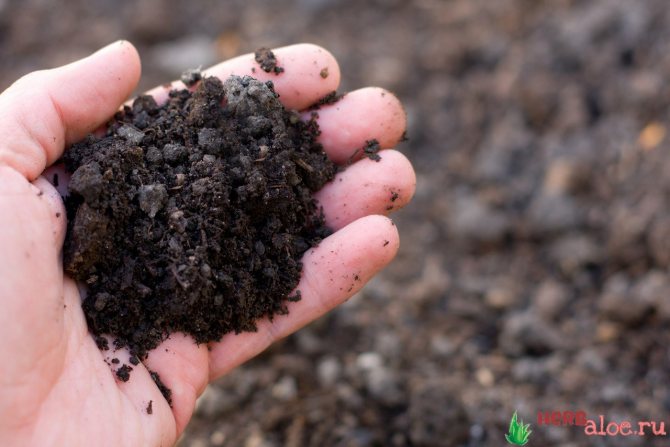

How to cut a leaf correctly?
Cut off a leaf from an adult plant at a short distance from the stem... Cut with a clean, sharp tool at a slight angle. The cut site must be treated with activated carbon powder and dried. The leaf is stored in a dark, dry place for several days.


It is imperative to wait for the formation of a film, it serves:
- A protective barrier against the entry of pathogens and infections from soil and water.
- An accumulator of nutrients from the leaf, which will be necessary for further growth and development.
After the formation of a film, the plant can be prepared for planting for further cultivation as a separate flower.

